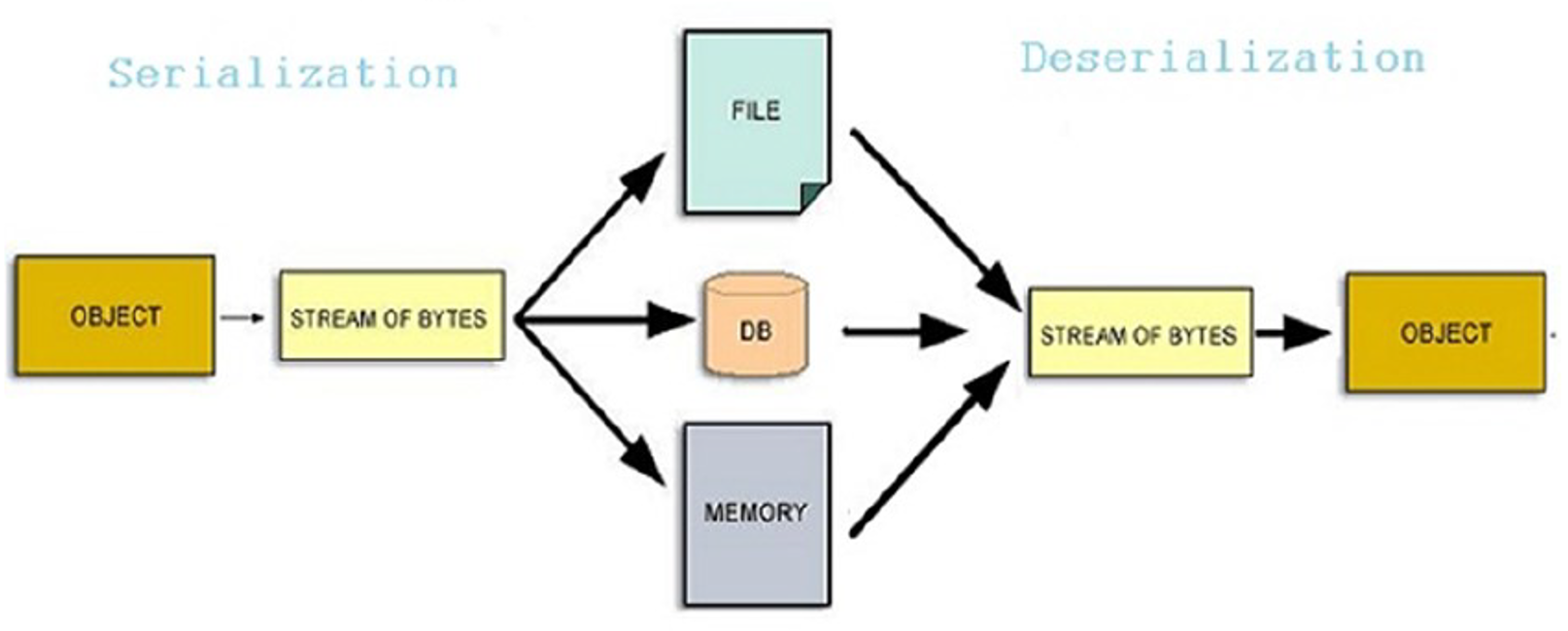💾 What Is Serialization?
Serialization is the process of converting an object into a data format such as a string or stream so it can be stored in a file or sent over the network. Deserialization is the reverse process which reconstructs the original object from that data.
In C# this is commonly done using libraries like System.Text.Json, System.Runtime.Serialization or System.Xml.Serialization.

🧱 Example: Serializing an Object to JSON
public class Product
{
public int Id { get; set; }
public string Name { get; set; }
}
// Create and serialize the object
var product = new Product { Id = 1, Name = "Book" };
string json = JsonSerializer.Serialize(product);
Console.WriteLine(json);
Output:
{"Id":1,"Name":"Book"}
🧱 Example: Deserializing JSON Back to an Object
string json = "{\"Id\":1,\"Name\":\"Book\"}";
// Convert JSON string back to object
Product deserializedProduct = JsonSerializer.Deserialize<Product>(json);
Console.WriteLine(deserializedProduct.Name); // Output: Book
This mechanism is essential for scenarios such as caching, web APIs, file storage and inter-service communication.
📦 Example: Writing to and Reading from a File
// Serialize to file
File.WriteAllText("product.json", json);
// Read from file and deserialize
string fileJson = File.ReadAllText("product.json");
Product productFromFile = JsonSerializer.Deserialize<Product>(fileJson);
These examples show how serialization makes it easy to persist and retrieve objects as plain text. Whether you are building APIs, saving configuration or handling data between systems understanding this process is essential.
⚙️ Types of Serialization in C#
C# offers several serialization techniques each suitable for different use cases. Understanding these methods can help you choose the right one for your application.
🔘 Binary Serialization
Binary serialization transforms objects into a compact binary format which is efficient in terms of size and performance. It requires the [Serializable] attribute on classes.
Usage:
[Serializable]
public class Person
{
public string Name;
public int Age;
}
This format is ideal when performance and data size matter. However it is not human-readable and should not be used in scenarios where data portability or inspection is needed.
📦 SOAP Serialization
SOAP serialization converts an object into XML using the Simple Object Access Protocol format. It is primarily used for communication with legacy web services that still rely on SOAP.
While mostly obsolete for modern APIs it may still be required in enterprise environments.
🌐 JSON Serialization
JSON serialization is the most widely used format today. It converts objects into a JSON string which is lightweight readable and ideal for web APIs.
Example using System.Text.Json:
var json = JsonSerializer.Serialize(myObject);
var obj = JsonSerializer.Deserialize<MyClass>(json);
You can also use libraries like Newtonsoft.Json for more advanced features like custom converters or property filtering.
📄 XML Serialization
XML Serialization converts objects into XML format. It is supported through the System.Xml.Serialization.XmlSerializer class.
Only public properties and fields are serialized
Does not require
[Serializable]attributeGood for interoperability with systems that expect XML
XmlSerializer serializer = new XmlSerializer(typeof(Product));
serializer.Serialize(stream, product);
📄 Data Contract Serialization
Available through System.Runtime.Serialization, this method uses [DataContract] and [DataMember] attributes.
Offers more control over the serialization process
Supports both XML and JSON formats (with
DataContractJsonSerializer)
[DataContract]
public class Product
{
[DataMember]
public int Id { get; set; }
[DataMember]
public string Name { get; set; }
}
This is commonly used in WCF (Windows Communication Foundation) applications.
⚡ Custom Serialization (ISerializable Interface)
For complete control, you can implement the ISerializable interface. This lets you define exactly how each property is serialized and deserialized.
[Serializable]
public class CustomProduct : ISerializable
{
public string Name;
public CustomProduct() {}
protected CustomProduct(SerializationInfo info, StreamingContext context)
{
Name = info.GetString("CustomName");
}
public void GetObjectData(SerializationInfo info, StreamingContext context)
{
info.AddValue("CustomName", Name);
}
}
This is useful for complex or versioned data structures.
🌐 YAML and Other Formats (via Third-party Libraries)
Using libraries like YamlDotNet or MessagePack for C#, you can serialize to other formats such as:
YAML: Human-readable, ideal for configuration files
MessagePack: Compact binary format, faster and smaller than JSON
Protobuf (Protocol Buffers): Used by gRPC for highly efficient cross-platform serialization
🧪 Summary Table
Type | Format | Library / Attribute | Use Case |
|---|---|---|---|
Binary | Binary |
| Internal fast serialization |
JSON | JSON |
| Web APIs, modern apps |
SOAP | XML | Legacy APIs | Integration with old services |
XML | XML |
| Config files, interoperability |
Data Contract | XML or JSON |
| WCF, service contracts |
Custom (ISerializable) | Any |
| Full control, version tolerance |
YAML / MessagePack | YAML, Binary | Third-party libraries | Config, performance critical systems |
✅ Final Thoughts
Choosing the right serialization approach depends on your specific application needs. JSON is great for web APIs, XML is better for config or legacy and binary or MessagePack is optimal for speed and performance. Always consider readability, speed and compatibility when selecting your serialization strategy.